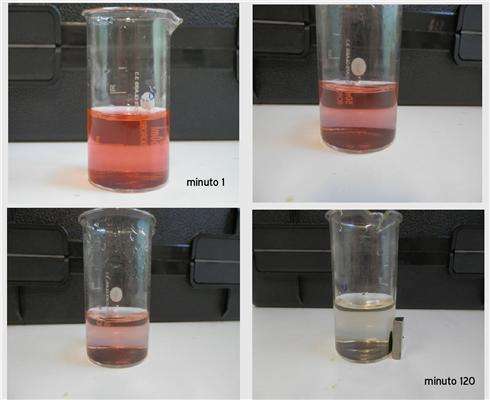Dissolution process of organic particles through nanoparticles
A researcher at the Public University of Navarre (UPNA) has developed nanostructures that assist in water decontamination. The nanostructures are coated in titanium oxide to which nitrogen has been added. This allows sunlight, rather than ultraviolet radiation, to trigger the process involving the chemical reaction and destruction of contaminants.
In her PhD thesis, Silvia Larumbe-Abuin describes these nanostructures. What is more, thanks to the magnetic nucleus of the particles, once the process has been carried out, they can be retrieved and reused. Silvia Larumbe's thesis is entitled, "Síntesis, caracterización y aplicaciones de nanoestructuras basadas en óxidos de metales de transición" [Synthesis, characterisation and applications of nanostructures based on transition metal oxides].
The basis of the research conducted is the phenomenon known as photocatalysis: When light affects a substance that acts as a catalyst, the speed of the chemical reaction is increased. In this case, the light activates the titanium oxide and different oxidizing radicals are formed; the latter destroy the organic contaminants in the water, which could be colouring agents, solvents, detergents, etc. As the author of the work explained, "it is a sustainable system that could be used as an alternative to different treatments used traditionally in waste water treatment and, specifically, to eliminate certain organic contaminants".
One of the advantages of this development is the possibility of using sunlight instead of ultraviolet light. "Since nitrogen is added to the coating of the particles, the mechanism that will trigger the process can be sunlight rather than ultraviolet radiation, which means a more accessible, less expensive alternative that poses fewer risks."
The fact that structures of a nanometric size are used also improves photocatalytic capability since the surface of the photocatalyst is greater. Another advantage is the reuse of the catalysing component; since the nanostructures are formed using a magnetic nucleus, they can be retrieved by applying an external magnetic field.
More information: C. Gómez-Polo, S. Larumbe, J.M. Pastor. (2013). "Room temperature ferromagnetism in non magnetic doped TiO2 nanoparticles." Journal of Applied Physics 113 17B511
Journal information: Journal of Applied Physics
Provided by Elhuyar Fundazioa























